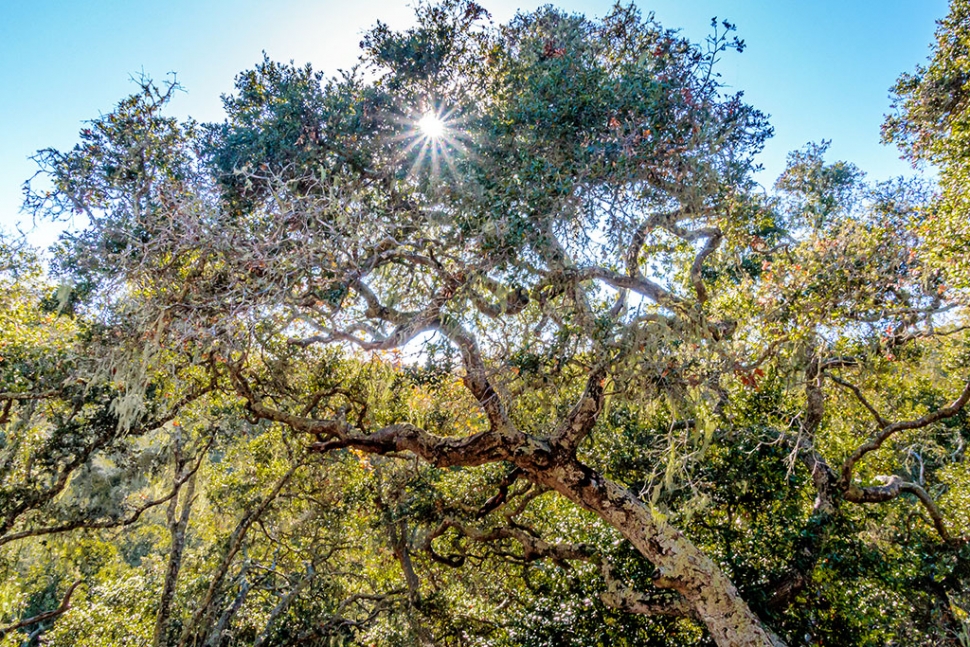|
Focus on Photography
 Photo of the Week: "An oak, some lichen, Spanish moss and a Sunstar" by Bob Crum. Ah! Photo data: Canon 7DMKII camera with Tamron 16-300mm lens @16mm, no filters. Exposure; ISO 1,000, aperture f/22, shutter speed 1/100 second. By Bob Crum — Wednesday, December 18th, 2019
Creative Photography Part 2
 Bob Crum My previous column concluded with notes about SOOC (Straight Out Of Camera) photography. Briefly, I wrote that some say that SOOC is stupid! Others say that photographers who use Photoshop (or some other photo editor program) simply don't know how to use their camera. Conversely, others say that SOOC photographers simply don't know how to use Photoshop. To wit I add: no image straight of the camera is as good as it can be. Which begs the question: How much better does the image need to be? SOOC purists claim that pristine unprocessed photos are superb. (sigh) Fact: All photos get processed in the camera. Light is converted to a digital file that is then processed by the camera's computer according to algorithms programmed by the camera engineers. Also, selecting a camera's 'picture style' setting will significantly affect the photo. An unprocessed SOOC image is a myth! If the SOOC photo is a snapshot in the JPEG format and destined only for social media, i.e., Facebook, Instagram, Twitter and email, it will most likely be satisfactory. At best, such photos will only get a nano-second glance anyway. Image quality is of little or no consequence because we know that snapshots made day in and day out aren't what could be considered 'creative' photos. Right? However, photography affords a high degree of creativity. But this creative aspect is not easily defined. In no quarter is there an agreed description or one that separates the craft from other mediums. But we can agree that through the application of various techniques both in-camera and in post-processing, creativity is integral. Mermaid boudoir photography is an extremely creative genre of photography in which I specialize. But I digress. The photographer begins the creative process by programming the camera. Beyond the essential fundamentals-focus & composition-options include aperture and shutter speed determinations. For instance, determine a shutter speed to blur a fast-moving subject or blur the background. Also, to create a stop-action waterfall or blur the flowing water for a silky look. Depth-of-field considerations and more. Beyond the technical aspects of a camera, a creative photographer sees things that most others overlook. The ability to see things, and see them from a unique perspective, is a significant component of creative photography. Composition is a foundation for creativity. Placement of the subject, including the decision to include negative space, often helps to separate the subject to draw attention to it. The use of color is another significant creative element. Think about using back-lit subjects to create a silhouette. Changing the perspective can create an uncommon and potentially interesting photo. If you're standing - kneel. Lay on the ground/floor. Or extend the camera high overhead. Note: Attaching your camera to your dog's tail as it walks down the street is not creative street photography: It's dogography! Though this is an abbreviated discussion on creative photography, there's one more important element: Intention. Intentionally capture the image as mentally envisioned to the best of your abilities and that of your camera. For example, the photo of the week is an old oak tree that I came upon as the sun was lowering in the south-western sky. Regular readers know I brake for sunstar photographic opportunities. Although the lower background is replete with vegetation and thus a tad busy, it's OK. All the other components make for a captivating photo. Observe it again. See the enchanting lichen creating texture on the tree trunk & limbs? How many see the Spanish moss? Aha, I thought so. It's on the lower left tree limbs. I instantly saw all of these eye-catching elements. I then programmed the camera to create the sunstar rays and intentionally made the photo. Ah, such is the ecstasy of creative photography. Say again? Did I do any post-processing? Stay tuned! Send comments, suggestions or questions to: focusonphotography@earthlink.net |
